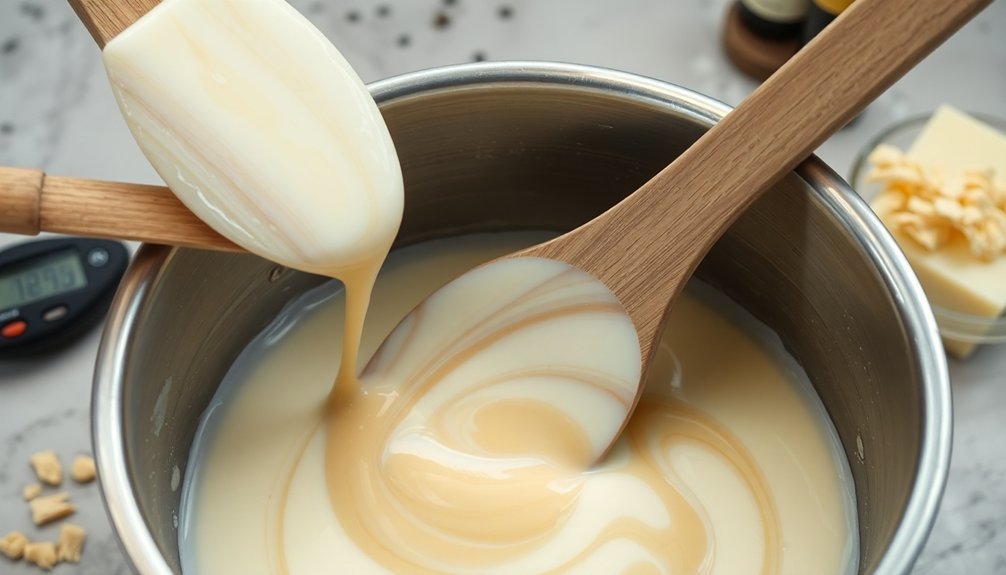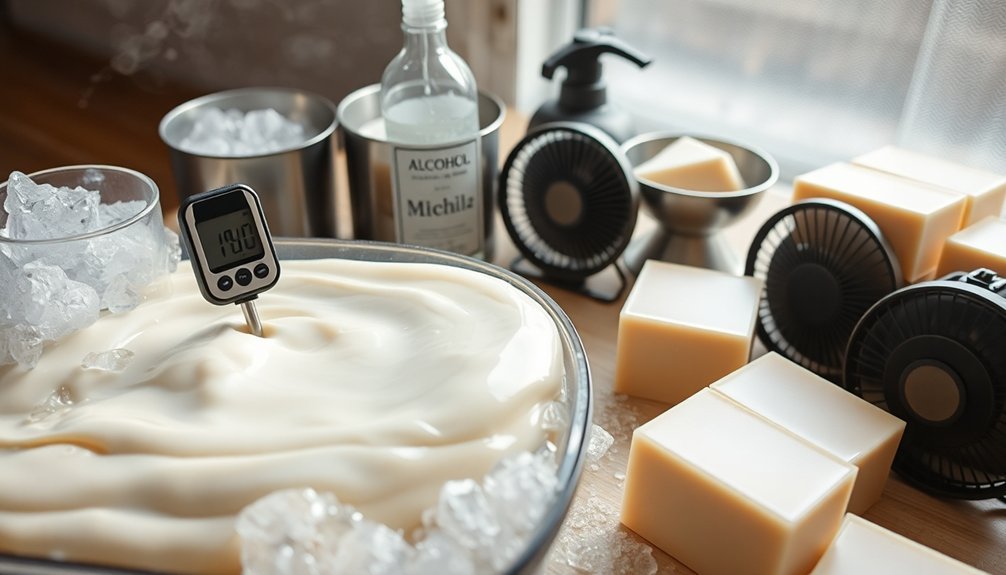You can save temperature-ruined soap batches through hot processing, rebatching, or cooling techniques. For separated soap, reheat to 160°F and blend thoroughly. If soap has seized, cut into small pieces, gently melt with added liquid, and remold. For overheated mixtures, use a cold water bath while stirring gently to release heat. Proper temperature monitoring (120-130°F) prevents most issues, but these rescue methods guarantee your soap-making efforts won't go to waste. The following methods will transform your failed batches into successful creations.
Rescuing Separated Soap: The Hot Process Method

When your soap batch has separated due to temperature issues, the hot process method offers an effective rescue technique. This hot process hero involves reheating your separated soap to at least 160°F, allowing oils to remelt and facilitating uniform blending throughout the mixture.
Once you've reached the proper temperature, thoroughly mix with a stick blender to reincorporate any separated oils into the batter. It's essential to monitor the temperature carefully to prevent overheating, which can cause further separation or foaming issues.
After achieving smooth consistency, pour the remelted soap into molds and let it cool and harden. This approach doesn't just save the soap—it can actually enhance your final product's qualities by creating a more rustic texture and appearance that many soap makers find appealing.
Rebatching Temperature-Seized Batches
Unlike separated soap batches, seized soap requires a different approach for salvation. The rebatching process can transform your temperature-seized soap into a usable product, though the final texture and appearance may differ from your original vision.
Begin by cutting your seized soap into small pieces to guarantee even melting.
Then follow these steps:
- Heat the soap pieces gently in a double boiler, adding 1-2 tablespoons of water or oil per pound to achieve a smoother consistency
- Stir continuously while melting to prevent overheating
- Pour the melted mixture quickly into your mold before it thickens
- Allow your rebatched soap to cure normally
This method gives your seized batch a second chance at becoming functional, usable soap.
Cooling Techniques for Overheated Soap Mixtures

Sometimes the best solution to a seized soap batch isn't rebatching but preventing the problem entirely by quickly addressing overheating. When your soap mixture reaches dangerous temperatures (above 160°F), place the container in a cold water bath, keeping water below the soap's rim to avoid contamination while promoting even cooling.
Gently stir to release heat without introducing air bubbles. For severely overheated mixtures, transfer to a heat-resistant glass container and refrigerate briefly. Adding small amounts of room temperature oils can help lower temperature without considerably altering soap composition.
Always monitor the temperature closely during cooling, aiming to bring it back to 120-130°F for proper saponification. This temperature control prevents common issues like false trace or separation that can ruin your batch and require more extensive intervention.
Frequently Asked Questions
How Do You Fix a Bad Batch of Soap?
You'll need to diagnose your soap's specific issue first. Try rebatching by cutting and remelting it, adding distilled water if separated, gently reheating solidified batches, or spritzing alcohol on soda ash formations.
What to Do With Failed Cold Process Soap?
When you've got failed cold process soap, don't toss it! You can rebatch it by grating, adding moisture, and reheating, or use it as laundry soap. Even imperfect batches have salvageable qualities.
How to Keep Homemade Soap From Going Rancid?
Use fresh oils with low peroxide values, add antioxidants like vitamin E, store your soap in cool, dry places away from sunlight, guarantee complete saponification, and create balanced recipes with mixed hard and soft oils.
How to Save Soap From Melting?
To save soap from melting, immediately move it to a cooler area. You'll need to monitor temperatures carefully, keeping it below 160°F if remelting. Add a little water if necessary and insulate molds afterward.
In Summary
Don't despair when your soap making goes awry due to temperature issues. You've now got three effective methods to save your batches. Whether you're hot processing a separated mix, rebatching seized soap, or cooling down an overheated mixture, you'll prevent waste and might even discover techniques you prefer. Remember, soap making is both science and art—mistakes often lead to your most creative solutions.





Leave a Reply